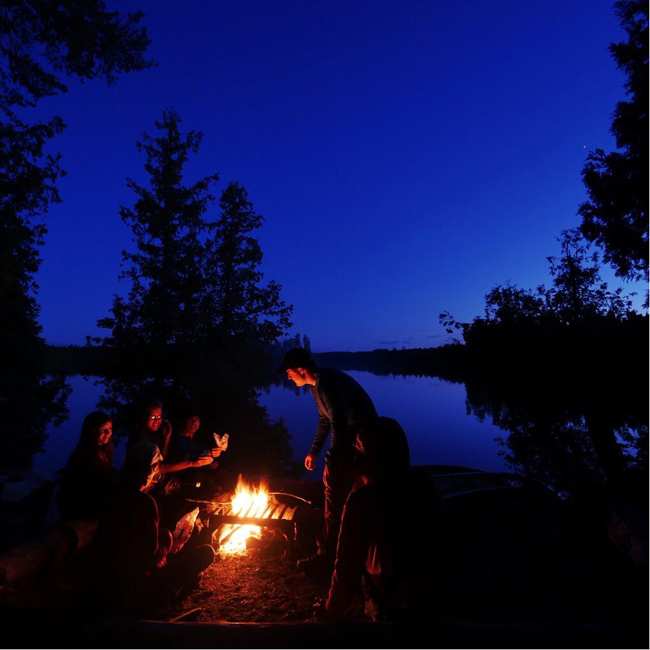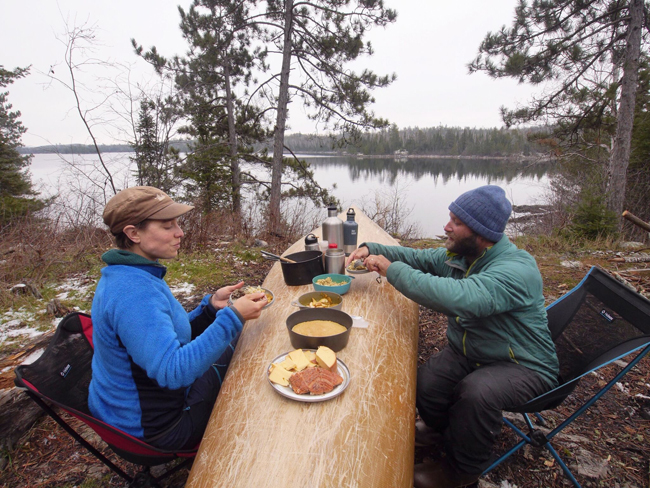
This post is sponsored by the Campaign to Save the Boundary Waters.
By Dave Freeman
When Amy and I paddled into the Boundary Waters Canoe Area Wilderness on Sept. 23, 2015, the first day of our year in the wilderness, we carried about 60 pounds of mostly dried food with us. Lots of rice, lentils, oatmeal, granola, powdered milk, and other staples filled our food pack. Sure there was a cabbage and a handful of apples and oranges that we ate quickly to lighten our pack, but most of our food was pretty plain. We were on a budget, and we were more focused on photographing and sharing the Boundary Waters than what was for dinner. We shared what we thought we might be dining on with the Heavy Table last September, right before we departed.
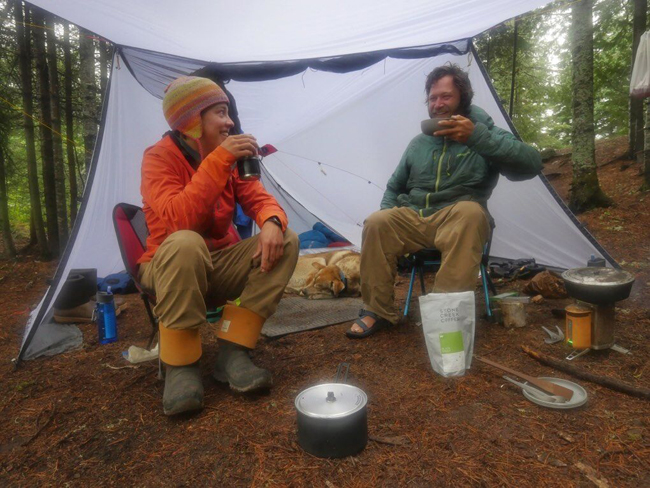
We have been in the wilderness continuously for almost a year now in an effort to stop Twin Metals and other proposed sulfide-ore copper mines that threaten this national treasure (learn more from the Campaign to Save the Boundary Waters). We are still eating a lot of rice and lentils, and we haven’t set foot in a restaurant — or any building for that matter — in almost a year, but good food has played a surprisingly large role in our year in the wilderness.
Let me explain. When we entered the wilderness last fall we were a little concerned that people would forget about us, but when our canoe hit the water that proved to be an irrational fear. We have had close to 300 people paddle, snowshoe, hike, ski, and dog sled out into the wilderness to visit us, and more often than not they have brought food.
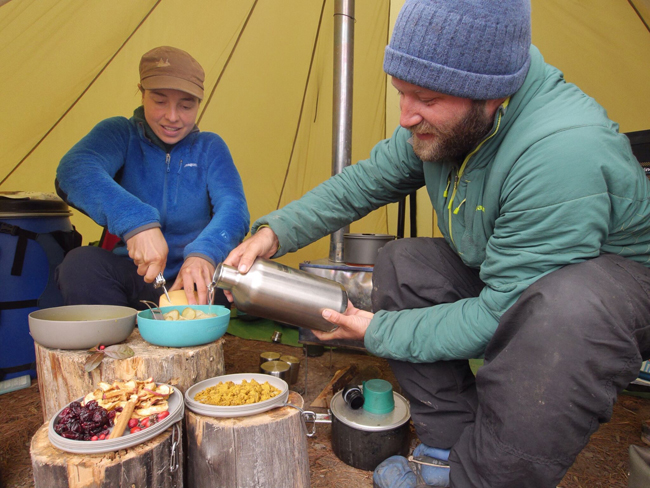
I am not talking stale crackers and moldy cheese. I am talking about strangers tracking us down to fill our pockets with gourmet chocolate, exquisite responsibly-sourced coffee that folks roasted themselves, succulent whole-roasted chickens brought in by dog sled, and root-beer floats paddled in on dry ice on a hot summer day. The truth is, we are eating better out here in the wilderness than we usually do at home, and we have developed a $75 a month chocolate habit, which is going to be hard to break when we exit the wilderness after a year on Sept. 23. Sometimes we’ve even been lucky to have a great chef meet us for a meal, as when Lukas Leaf came to visit. And we’ve made the most out of the holidays we’ve marked out here, like Thanksgiving (above and top) and birthdays (below).

I think some people assume that we are hunting and gathering most of our food, eating berries, fish, cattail tubers, and grubs. The truth is, that while we do fish, and while we ate a lot of blueberries in July, when they were big and succulent (we added them to our muesli and picked handfuls to munch on while portaging), most of our food comes from the grocery store. However, while everyone flocked to the Minnesota State Fair, we headed for a series of shallow lakes and rivers to harvest wild rice.
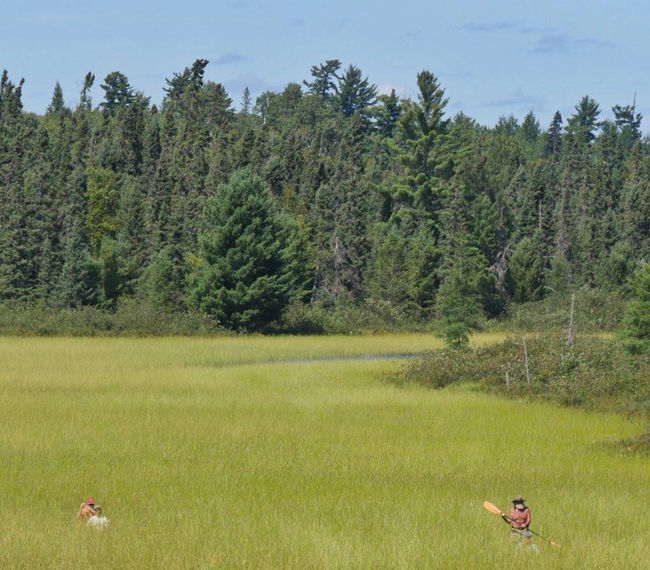
The tick, tick, tick, sound of ripe wild rice kernels landing in the canoe signals that you are in a good spot and the rice is ripe. My wife, Amy, paddled and pushed the canoe through the thick rice, which was tall enough that about all I could see was the green stalks of rice and the blue sky. This was our first time ricing, but we quickly fell into a rhythm, enjoying the subtle sounds of the rice landing, talking about the rice, and chatting about a variety of things, all the while carefully bending the rice over the canoe with one flail and lightly stroking it with the other. Flails are thin sticks (traditionally cedar) no more than 30 inches long. If everything goes as planned, the ripe rice kernels fall into the canoe and the unripe kernels remain on the stalk. You are allowed to harvest wild rice only from 9 a.m. until 3 p.m., so as 3 p.m. approached, we paddled out of the rice bed and prepared to head back to camp.
We carefully scooped handfuls of rice into one of our packs for the trip back to our campsite. Then we spread the rice out on tarps to dry in the sun and sifted through the kernels, hunting for small, white, rice-eating grubs. Soon small fish were splashing in the shallows as they gobbled up the grubs that we pitched into the water.
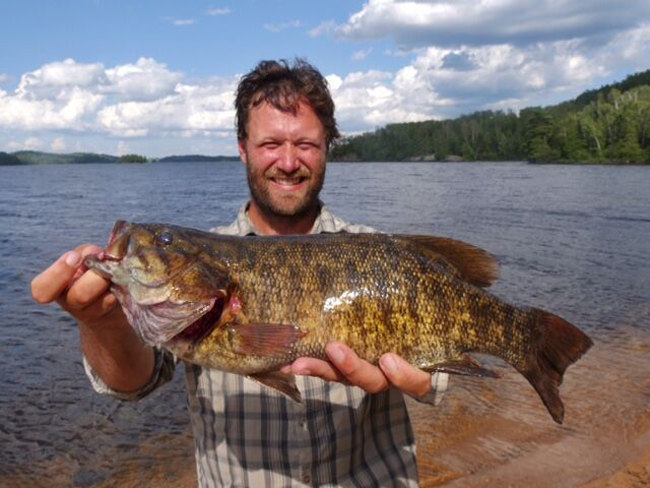
Over the years we have picked our fair share of berries and fried up plenty of fish, but we have never gathered food in such a deliberate and steady manner. What a wonderful gift these clean lakes and streams offer us. Gathering wild rice connects us to the land. We haven’t tasted a single grain of this rice yet, but I feel nourished in ways that a trip to the grocery store can’t provide.
Several friends came into the wilderness to teach us how to rice. They hauled the 50-plus pounds of rice we harvested back to their car and will take it to a processor along with their rice. Our rice probably will not be processed before we leave the wilderness, but we look forward to eating some of it in about a month.
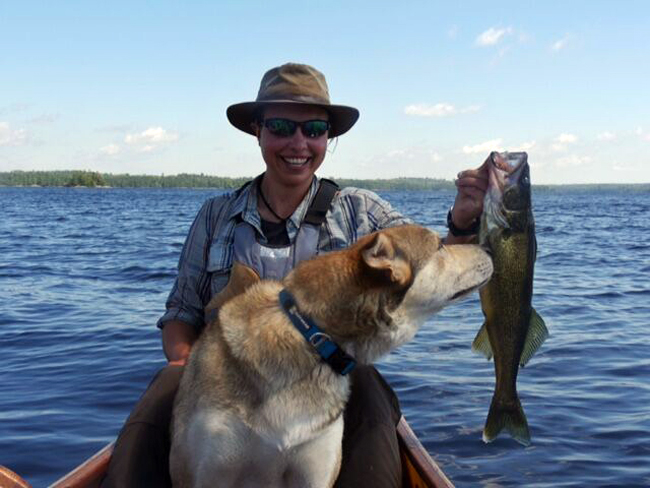
Luckily, our expedition manager purchased hand-harvested wild rice from North Central Minnesota in bulk for us, so we have plenty of wild rice to eat. The hand-harvested and hand-parched wild rice is a little more expensive, but it is far superior to commercially grown “wild rice.” Hand-parched rice cooks much faster and is absolutely delicious. It is one of our dinner staples, and we often substitute it for white or brown rice. It’s great in a stir fry, with lentils, or with just about any dish in which you would normally use white rice. We normally make it plain or mixed with lentils, but if you add some dried organic cranberries and a little chicken broth, it is even better.
One of our favorite lunches is Patagonia Provisions smoked salmon. We often eat it with a little mayo on bagels or use a tortilla to make a salmon wrap. Because we don’t have refrigeration, we use individual mayo packets, the same ones you get at fast food restaurants. If we have them, we love to add lettuce, tomato slices, and avocado, and of course cheese. Mild cheddar or pepper jack are our favorites for this trail lunch.
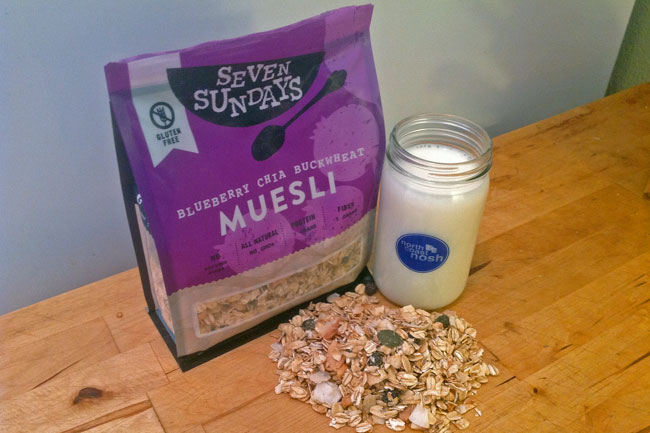
For breakfast, we have settled on Seven Sundays Muesli with whole powdered milk as our standby. Seven Sundays makes a whole host of flavors, so it is fun to pick and choose. If we are expecting an extra-long day, we often add a spoonful of peanut butter, which is especially good with the Bircher Apple Cinnamon flavor. Plus, breakfast wouldn’t be complete without coffee! We use a one-cup coffee filter made by MSR. It’s great for camping because it is small and simple to use, and it allows you to make a single cup quickly.
Of course there are times when we are cold, wet, and hungry, and we just want a hot, tasty meal fast. We try to carry a couple “cook in the bag” freeze-dried meals for these occasions. We like Trailtopia freeze-dried meals because they are easy, taste good, and can be cooked and eaten right out of the bag, so there aren’t any dishes to clean. Trailtopia Oatmeal with Mango Chunks, Chicken Pesto, and Ramen Noodles with Beef, Mushrooms, and Vegetables are some of our favorites.

When we paddled into the wilderness nearly a year ago, we saw food as the fuel we would need to keep our bodies going. Our food spreadsheet was filled with hundreds of tortillas, 300 pounds of trail mix, 50 pounds of dehydrated veggies, and 170 pounds of cheese, a massive list to be meted out and delivered approximately every two weeks by volunteers who would trek into the wilderness, assuming they didn’t forget about us. You should see what a 10-day resupply list looked like.
In the end, the food that we have eaten — and the dedicated people who brought it to us — fuels our spirit as much as our bodies. I think it’s the same anywhere; when we share good food with good people it nourishes us in a whole host of ways. We also want to share the wonder of this wilderness, and that’s why we took on this experience, which concludes in Ely on Sept. 23. You can help our efforts by signing the petition at SavetheBoundaryWaters.org.
